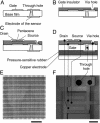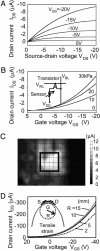A large-area, flexible pressure sensor matrix with organic field-effect transistors for artificial skin applications
- PMID: 15226508
- PMCID: PMC454198
- DOI: 10.1073/pnas.0401918101
A large-area, flexible pressure sensor matrix with organic field-effect transistors for artificial skin applications
Abstract
It is now widely accepted that skin sensitivity will be very important for future robots used by humans in daily life for housekeeping and entertainment purposes. Despite this fact, relatively little progress has been made in the field of pressure recognition compared to the areas of sight and voice recognition, mainly because good artificial "electronic skin" with a large area and mechanical flexibility is not yet available. The fabrication of a sensitive skin consisting of thousands of pressure sensors would require a flexible switching matrix that cannot be realized with present silicon-based electronics. Organic field-effect transistors can substitute for such conventional electronics because organic circuits are inherently flexible and potentially ultralow in cost even for a large area. Thus, integration of organic transistors and rubber pressure sensors, both of which can be produced by low-cost processing technology such as large-area printing technology, will provide an ideal solution to realize a practical artificial skin, whose feasibility has been demonstrated in this paper. Pressure images have been taken by flexible active matrix drivers with organic transistors whose mobility reaches as high as 1.4 cm(2)/V.s. The device is electrically functional even when it is wrapped around a cylindrical bar with a 2-mm radius.
Figures




Similar articles
-
Conformable, flexible, large-area networks of pressure and thermal sensors with organic transistor active matrixes.Proc Natl Acad Sci U S A. 2005 Aug 30;102(35):12321-5. doi: 10.1073/pnas.0502392102. Epub 2005 Aug 17. Proc Natl Acad Sci U S A. 2005. PMID: 16107541 Free PMC article.
-
Large-Area High-Performance Flexible Pressure Sensor with Carbon Nanotube Active Matrix for Electronic Skin.Nano Lett. 2018 Mar 14;18(3):2054-2059. doi: 10.1021/acs.nanolett.8b00063. Epub 2018 Feb 20. Nano Lett. 2018. PMID: 29442518
-
High-speed and large-scale intrinsically stretchable integrated circuits.Nature. 2024 Mar;627(8003):313-320. doi: 10.1038/s41586-024-07096-7. Epub 2024 Mar 13. Nature. 2024. PMID: 38480964
-
Artificial Skin Perception.Adv Mater. 2021 May;33(19):e2003014. doi: 10.1002/adma.202003014. Epub 2020 Sep 15. Adv Mater. 2021. PMID: 32930454 Review.
-
Large-scale integration of semiconductor nanowires for high-performance flexible electronics.ACS Nano. 2012 Mar 27;6(3):1888-900. doi: 10.1021/nn204848r. Epub 2012 Mar 7. ACS Nano. 2012. PMID: 22364279 Review.
Cited by
-
A sub-1V, microwatt power-consumption iontronic pressure sensor based on organic electrochemical transistors.IEEE Electron Device Lett. 2021 Jan;42(1):46-49. doi: 10.1109/led.2020.3042310. Epub 2020 Dec 3. IEEE Electron Device Lett. 2021. PMID: 33746352 Free PMC article.
-
A localized surface plasmon resonance imaging instrument for multiplexed biosensing.Anal Chem. 2013 May 7;85(9):4560-6. doi: 10.1021/ac400192f. Epub 2013 Apr 19. Anal Chem. 2013. PMID: 23560643 Free PMC article.
-
Studies on the electrostatic effects of stretched PVDF films and nanofibers.Nanoscale Res Lett. 2021 May 3;16(1):79. doi: 10.1186/s11671-021-03536-9. Nanoscale Res Lett. 2021. PMID: 33939029 Free PMC article.
-
Chronically implanted pressure sensors: challenges and state of the field.Sensors (Basel). 2014 Oct 31;14(11):20620-44. doi: 10.3390/s141120620. Sensors (Basel). 2014. PMID: 25365461 Free PMC article. Review.
-
Bio-Inspired Strategies Are Adaptable to Sensors Manufactured on the Moon.Biomimetics (Basel). 2024 Aug 15;9(8):496. doi: 10.3390/biomimetics9080496. Biomimetics (Basel). 2024. PMID: 39194475 Free PMC article. Review.
References
-
- Nicholls, H. R. & Lee, M. H. (1989) Int. J. Robotics Res. 8, 3-30.
-
- Lee, M. H. & Nicholls, H. R. (1999) Mechatronics 9, 1-31.
-
- Tsumura, A., Koezuka, H. & Ando, T. (1986) Appl. Phys. Lett. 49, 1210-1212.
-
- Burroughes, J. H., Jones, C. A. & Friend, R. H. (1988) Nature 335, 137-141.
-
- Sirringhaus, H., Tessler, N. & Friend, R. H. (1998) Science 280, 1741-1744. - PubMed
Publication types
MeSH terms
LinkOut - more resources
Full Text Sources
Other Literature Sources

